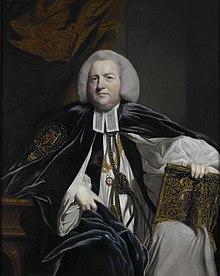Robert Hay Drummond
|
The Most Reverend and Right Honourable Robert Hay Drummond |
|
|---|---|
| Archbishop of York | |

Portrait of Hay Drummond in 1764 by Joshua Reynolds
|
|
| Province | Province of York |
| Diocese | Diocese of York |
| Elected | 3 October 1761 (elected) 23 October 1761 (confirmed) |
| Term ended | 1776 (death) |
| Predecessor | John Gilbert |
| Successor | William Markham |
| Other posts |
Bishop of St Asaph (1748–1761) Bishop of Salisbury (11 June–23 October 1761) Lord High Almoner (1761–?) |
| Personal details | |
| Birth name | Robert Hay |
| Born |
10 November 1711 London, England |
| Died | 10 December 1776 (aged 65) Bishopthorpe, Yorkshire (West Riding), Great Britain |
| Buried | 10 December 1776, St Andrew's Church (the second), Bishopthorpe |
| Nationality | British (previously English) |
| Denomination | Anglican |
| Residence | Brodsworth Hall, Yorkshire (West Riding; private) |
| Parents | George Hay, 8th Earl of Kinnoull & Abigail Countess of Kinnoull (née Harley) |
| Spouse | Henrietta Auriol (m. 1749) {she died}) |
| Children | 3 daughters & 6 sons: Robert Hay-Drummond, 10th Earl of Kinnoull Edward Hay-Drummond |
| Profession | Bishop |
| Education | Westminster School |
| Alma mater | Christ Church, Oxford |
| Ordination history of Robert Hay Drummond | |
|---|---|
|
Diaconal ordination
|
|
| Ordained by | John Potter, Bishop of Oxford |
| Date of ordination | 26 June 1736 |
|
Priestly ordination
|
|
| Ordained by | Potter |
| Date of ordination | 27 June 1736 |
|
Episcopal consecration
|
|
| Date of consecration | 24 April 1748 |
| Place of consecration | "Kensington Church" |
| Source(s): | |
Robert Hay (10 November 1711 – 10 December 1776), known later as Robert Hay-Drummond of Cromlix and Innerpeffray, was Archbishop of York from 1761 to 1776.
Hay was the second son of George Hay, Viscount Dupplin (who succeeded his father as eighth Earl of Kinnoull, in 1719), and Abigail, the youngest daughter of Robert Harley, 1st Earl of Oxford and Earl Mortimer, Lord High Treasurer. He was born in London on 10 November 1711. His birth was mentioned by Jonathan Swift in the Letters to Stella, and his infancy is thus referred to by Richard Bentley in the dedication of his edition of Horace to Lord Oxford, on 8 December 1711: Parvulos duos ex filia nepotes, quorum alter a matre adhuc rubet. ("Two small grandsons from his daughter, of whom one is still red from his mother").
At age 6, he was brought by Matthew Prior to Westminster School, of which Robert Freind was then head-master. There he was admired, "for his talents, and beloved for the pleasantry of his manners, and forming many valuable friendships among his schoolfellows." While still a boy at Westminster he acted in the play Julius Caesar before an audience including George II and Queen Caroline. His continuation of his part even when his plume of ostrich feathers caught fire attracted the notice of the queen, who continued his warm patroness till her death in 1737. From Westminster he moved to Christ Church, Oxford. Having after receiving his BA degree on 25 November 1731, he joined his cousin, Thomas, duke of Leeds, in the Grand Tour. When he came home afterwards in 1735 his uncle not only commented that he was not only 'untainted, but much improved'. He had been originally destined for the army, but on his return to England he went back to Christ Church and took his MA degree 13 June 1735. He then read divinity with a view to his entrance into holy orders.
...
Wikipedia
